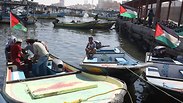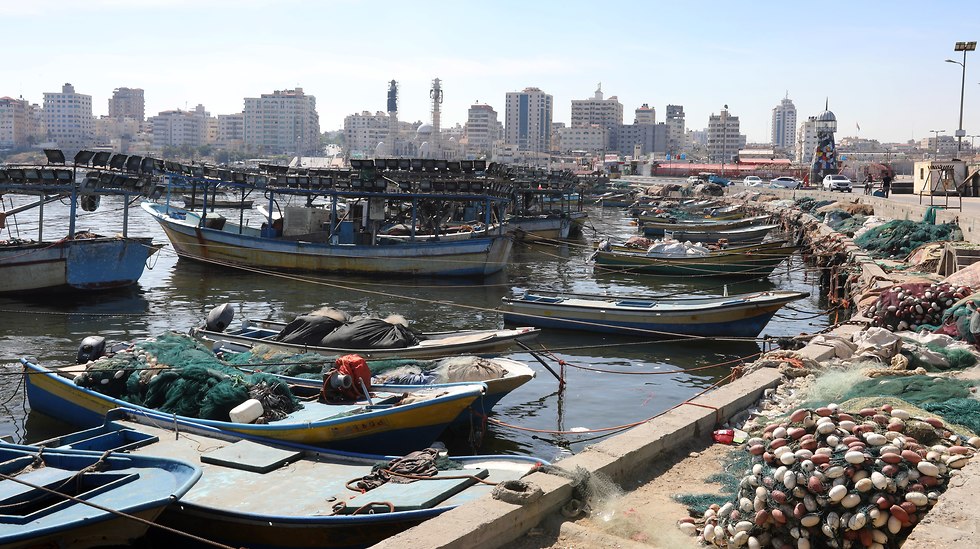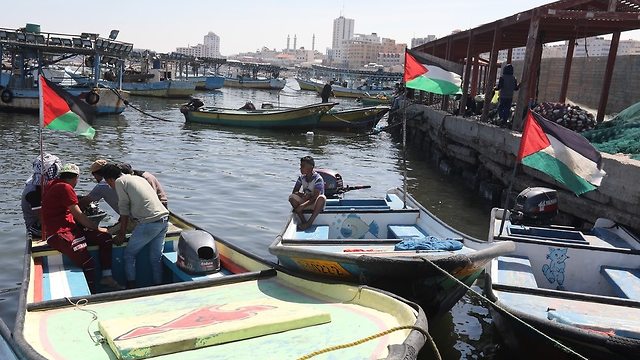
Gaza port
Photo: EPA
Absent terror, a Gazan sea port would open the strip for business
Op-ed: Without a terrorist leadership, a Gazan sea port would yield industry, investment and energy sources for the embattled enclave, transforming it into a hive of economic, upward mobility for decades to come.
The challenges facing the Gaza Strip are multiple and growing, both on land and at sea. They impact upon the wellbeing of its inhabitants. These challenges keep the Hamas-ruled territory isolated and underdeveloped, with chronic overcrowding and a lack of a functioning economy.
But the formation of a new Palestinian political entity, which encompasses both Gaza and a part of the adjacent northern Sinai Peninsula, could go a long way to solving these issues.
From a sea-based perspective, Gaza faces numerous problems. These include constant security friction between Gazan boats and the Israeli Navy in nearby Israeli territorial waters, overcrowded fishing spaces, and the lack of an international sea port. These challenges place Gaza’s development and stability in jeopardy.
A New State Solution would open the Palestinians in the Gaza Strip to the wider world. A shipping port would facilitate large-scale trade, revitalize the Gazan economy, and help bring stability.
A wider Gaza—Sinai political entity could lead to the construction of a port large enough for a state, with suitable sea access, and a nearby industrial zone to support the port’s daily activities.
A large new port is under construction in the southern Israeli city of Ashdod at this time, meaning that the precedent for such a large-scale project in the region is already being set. The sea port model being followed by Israelis can be replicated for Gaza.
The new port could be built along the Sinai coastline, though it would have to be done in such a way that it would avoid causing major ecological damage to the local marine eco-system. The port must not block the natural sand movements that occur underwater in the Mediterranean Sea, from the Nile Delta northwards towards the Israeli coastline.
The exact location for the port along the Sinai Peninsula should be to the subject of further research to reduce and avoid potential ecological damage. It would seem that further south-west along the Sinai peninsula would be the best location for it.
It is clear that if the new Palestinian state is run by a terrorist entity, like Gaza is today, a port, even a distant one, can create and pose serious security threats to Israel. Hence, for such a project—a port—to be truly viable, the new Palestinian entity must be run by a non-terrorist government. Such a government cannot be guided by a fundamentalist anti-Israel ideology. In such a scenario, international investment can begin pouring into Gaza, and a port can create vital access to the outside world.
The waters off the Sinai Peninsula are not very active at the moment, so there is room to build the new port. Gaza’s fishermen could operate off the Sinai coastline as well. This would address another problem that Gaza currently faces - overfishing - which has led to the amount of fish being drastically reduced in the coastal waters off Gaza.
Gazan fishermen must make a living, but the lack of any limits to their activities, and Israel’s need to restrict their movements to a limited area, to avoid security risks, has produced an unhealthy effect on the local marine eco-system.
Israel has placed naval restrictions around Gaza for security reasons. Hamas’s doctrine involves organizing terrorist, sea-based attacks (in the form of bomb-laden boats, for example), using civilian fishing vessels as a cover.
This pattern follows the classic terrorist modus operandi of launching operations from among civilians.
The proximity of Gaza to Israel’s territorial waters, as well as southern Israeli coastal cities, and offshore Israeli gas drilling rigs, means that a constant friction exists between Gaza and Israel in the Mediterranean Sea.
All of these problems could be significantly reduced by widening Gaza’s sea area southwards, and stretching it out to include the Mediterranean waters off the north Sinai coastline. Such a solution could be part of the New State Solution encompassing Gaza and the designated territory in the northern Sinai.
The new Palestinian state and Israel could agree to move fishing boats away from the Israeli border. By doing so, both the security risk and the daily friction between Israel and Gaza would decrease substantially by way of the new state. This would also create larger fishing areas, benefiting both Gaza’s fishing industry, and the marine eco-system. Gazans could begin setting up fish farms, for example. Israel could end the need to constantly change the fishing zone for Gazans in accordance with the latest security evaluations.
Additionally, for the Palestinians, the New State Solution opens the door to offshore gas exploration. Although it would take at least two decades for suitable infrastructure to develop, the potential for Gazans to have their own energy source would be highly beneficial for Gaza’s economy, and pave the path for heightened regional cooperation between Gaza, Israel, and the wider Arab world, which could cooperate in developing such a project.
Ultimately, the creation of such a state can lead to a new reality, which is something no one has truly tried to accomplish in the region since the 1979 Camp David Accord between Egypt and Israel.
With the passage of several decades from that time to this, I believe the time may be ripe for new ideas that are both bold and pragmatic.













